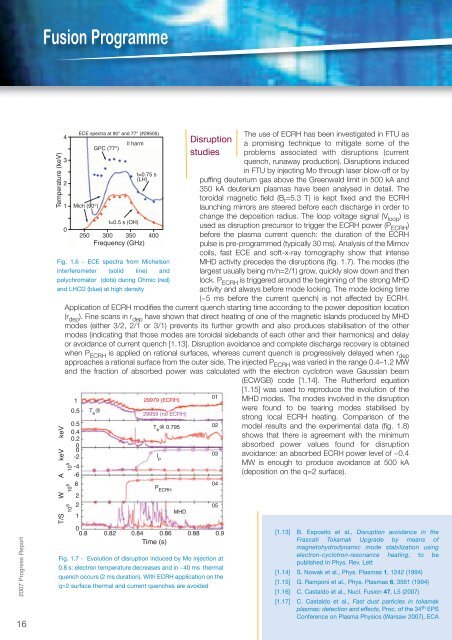Fusion Programme - ENEA - Fusione
Fusion Programme - ENEA - Fusione
Fusion Programme - ENEA - Fusione
- No tags were found...
You also want an ePaper? Increase the reach of your titles
YUMPU automatically turns print PDFs into web optimized ePapers that Google loves.
<strong>Fusion</strong> <strong>Programme</strong>2007 Progress Report16Temperature (keV)43210ECE spectra at 90° and 77° (#29505)Mich (90°)GPC (77°)ll harmt=0.5 s (OH)t=0.75 s(LH)250 300 350 400Frequency (GHz)Fig. 1.6 - ECE spectra from Michelsoninterferometer (solid line) andpolychromator (dots) during Ohmic (red)and LHCD (blue) at high densitykeVkeVAWT/SThe use of ECRH has been investigated in FTU asa promising technique to mitigate some of theproblems associated with disruptions (currentquench, runaway production). Disruptions inducedin FTU by injecting Mo through laser blow-off or bypuffing deuterium gas above the Greenwald limit in 500 kA and350 kA deuterium plasmas have been analysed in detail. Thetoroidal magnetic field (B t =5.3 T) is kept fixed and the ECRHlaunching mirrors are steered before each discharge in order tochange the deposition radius. The loop voltage signal (V loop ) isused as disruption precursor to trigger the ECRH power (P ECRH )before the plasma current quench: the duration of the ECRHpulse is pre-programmed (typically 30 ms). Analysis of the Mirnovcoils, fast ECE and soft-x-ray tomography show that intenseMHD activity precedes the disruptions (fig. 1.7). The modes (thelargest usually being m/n=2/1) grow, quickly slow down and thenlock. P ECRH is triggered around the beginning of the strong MHDactivity and always before mode locking. The mode locking time(~5 ms before the current quench) is not affected by ECRH.DisruptionstudiesApplication of ECRH modifies the current quench starting time according to the power deposition location(r dep ). Fine scans in r dep have shown that direct heating of one of the magnetic islands produced by MHDmodes (either 3/2, 2/1 or 3/1) prevents its further growth and also produces stabilisation of the othermodes (indicating that those modes are toroidal sidebands of each other and their harmonics) and delayor avoidance of current quench [1.13]. Disruption avoidance and complete discharge recovery is obtainedwhen P ECRH is applied on rational surfaces, whereas current quench is progressively delayed when r depapproaches a rational surface from the outer side. The injected P ECRH was varied in the range 0.4–1.2 MWand the fraction of absorbed power was calculated with the electron cyclotron wave Gaussian beam(ECWGB) code [1.14]. The Rutherford equation10.50.50.40.20-210 5 10 5 10 5-4-66221T e@29979 (ECRH)29959 (no ECRH)T e@ 0.79500.8 0.82 0.84 0.86 0.88 0.9Time (s)l pP ECRHMHDFig. 1.7 - Evolution of disruption induced by Mo injection at0.8 s: electron temperature decreases and in ~40 ms thermalquench occurs (2 ms duration). With ECRH application on theq=2 surface thermal and current quenches are avoided0102030405[1.15] was used to reproduce the evolution of theMHD modes. The modes involved in the disruptionwere found to be tearing modes stabilised bystrong local ECRH heating. Comparison of themodel results and the experimental data (fig. 1.8)shows that there is agreement with the minimumabsorbed power values found for disruptionavoidance: an absorbed ECRH power level of ~0.4MW is enough to produce avoidance at 500 kA(deposition on the q=2 surface).[1.13] B. Esposito et al., Disruption avoidance in theFrascati Tokamak Upgrade by means ofmagnetohydrodynamic mode stabilization usingelectron-cyclotron-resonance heating, to bepublished In Phys. Rev. Lett[1.14] S. Nowak et al., Phys. Plasmas 1, 1242 (1994)[1.15] G. Ramponi et al., Phys. Plasmas 6, 3561 (1994)[1.16] C. Castaldo et al., Nucl. <strong>Fusion</strong> 47, L5 (2007)[1.17] C. Castaldo et al., Fast dust particles in tokamakplasmas: detection and effects, Proc. of the 34 th EPSConference on Plasma Physics (Warsaw 2007), ECA













